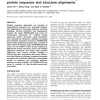820 search results - page 19 / 164 » Using Multiple Alignments to Improve Gene Prediction |
BMCBI
2011
12 years 11 months ago
2011
Background: Gene regulatory networks play essential roles in living organisms to control growth, keep internal metabolism running and respond to external environmental changes. Un...
NAR
2008
13 years 7 months ago
2008
Multiple sequence alignments are essential in computational sequence and structural analysis, with applications in homology detection, structure modeling, function prediction and ...
BMCBI
2006
13 years 7 months ago
2006
Background: Horizontal gene transfer (HGT) is considered a strong evolutionary force shaping the content of microbial genomes in a substantial manner. It is the difference in spee...
ICASSP
2010
IEEE
13 years 5 months ago
2010
IEEE
We investigate incremental word learning with few training examples in a Hidden Markov Model (HMM) framework suitable for an interactive learning scenario with little prior knowle...
BMCBI
2010
13 years 7 months ago
2010
Background: Much of the public access cancer microarray data is asymmetric, belonging to datasets containing no samples from normal tissue. Asymmetric data cannot be used in stand...

